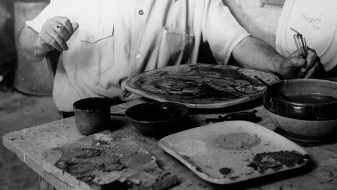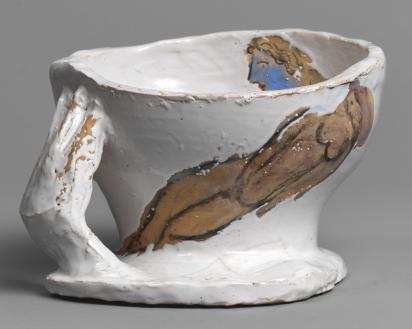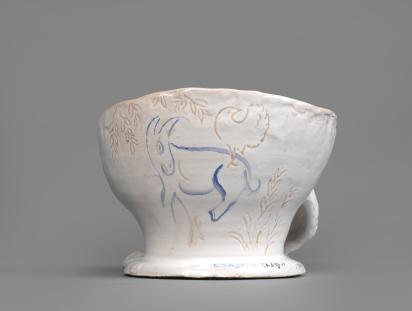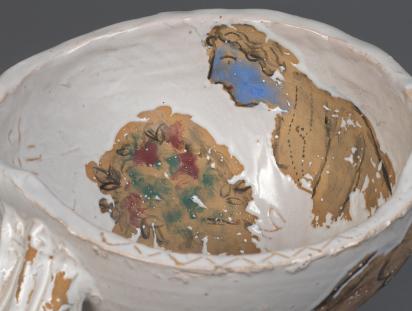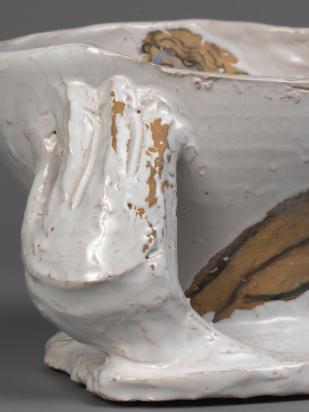Vase with Hand (1953), unique in Chagall's ceramic work on account of its craftsmanship, stands out for its raw form and the powerful hand that encircles the piece and serves as its handle. This “vase-sculpture”1, one of the artist’s most advanced technical experiments at the Madoura studio, pushes the boundaries of utilitarian ceramics and Vallaurian aesthetics. Very different from the work produced in Vallauris in the 1960s, the piece is surprising for its archaic aspect, the raw clay glazed in monochrome white and the search for a free form that rejects smoothness or refinement. It immediately reveals traces of modelling and the strength of the hands that embraced and kneaded the clay. On the belly and the interior, motifs are engraved and painted on the unfired clay, which is left unglazed. The surface features the fleshly presence of a reclining female nude recalling The Nude Cloud [Le Nuage nu] (1945 - 1946). The inside of the vase reveals a figure in profile holding a bouquet of flowers, finely engraved and painted. All the Madoura studio craftsmen witnessed Chagall's creative freedom, with the artist scarcely heeding their technical warnings or firing requirements2. Sculpted Vase [Vase sculpté] (1952) is another example of his exploration of the ceramic sculpture from his earliest work in the medium. This piece, which also features the iconographic element of the hand, symbolizing creation, the will of God, making and unmaking, has an irregular shape in the form of a half-empty vase. A woman's profile appears on the interior of the main side, following the contours of the unfired clay cut with a wire to create the distinctive shape. A hand responding to a yellow animal was modelled at the base of the piece. On the reverse, the round body features a flying couple and a floral design in shades of blue and lilac. The mainly decorative handle is placed very low on the piece, like an ear listening to all the voices heard by the Earth.
A.GCeramic
Vase With Hand
(Vase à la main)
- No. C-245
- 1953
- Vase
- ochre clay, decoration painted with brush in wax resist technique, oxides on white enamel, engraved with a knife
- 6 5/16 x 10 1/4 x 9 1/16 in. (16 x 26 x 23 cm)
-
Signed Chagall Chagall and dated 1953 on the base
- Musée national d'art moderne, Paris, France, AM 2022-405
Related works

Marc CHAGALL, White Vase and Hand (Variante en blanc des Amoureux en rose avec une main), 1962, white clay, cut with wire, engraved with a knife, 8 11/16 in. (22 cm), Private collection © François FERNANDEZ/ADAGP, Paris, 2025

Marc CHAGALL, Sculpted Vase (Vase sculpté), 1952, color clay, cut with a wire, decorated with slips and oxides, engraved with a knife and dry point needle, enameled with brush, 14 3/16 x 11 7/16 x 10 13/16 in. (36 x 29 x 27.5 cm), Musée national d'art moderne, Paris © Fabrice GOUSSET/ADAGP, Paris, 2025
